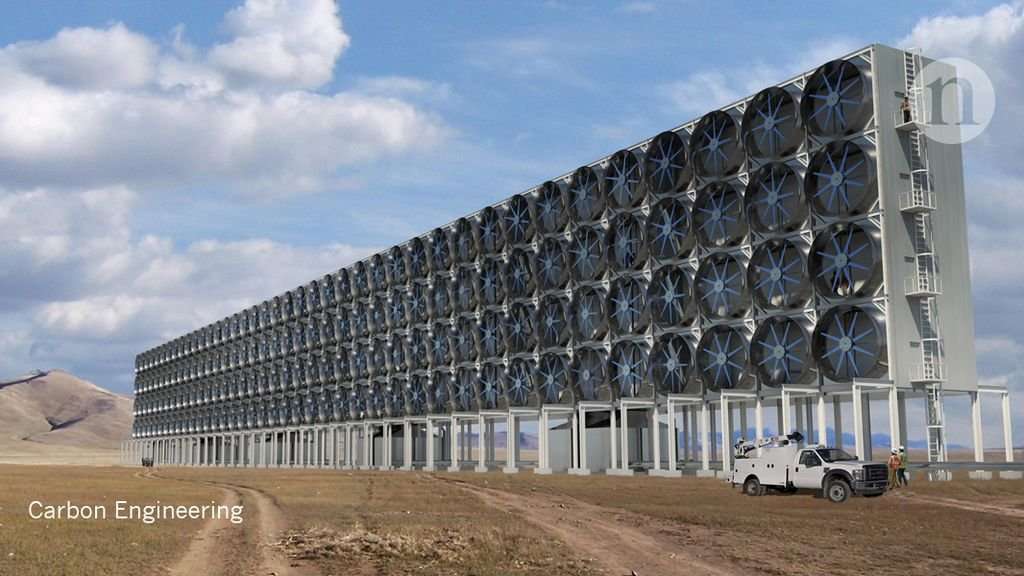This artist's rendering shows Carbon Engineering's design for an 'air contactor' to pull carbon dioxide from the atmosphere.credit: Carbon Engineering
Siphoning carbon dioxide (CO 2 ) from the atmosphere could be more than an expensive last-ditch strategy for averting climate catastrophe. A detailed economic analysis published on 7 June suggests that the geoengineering technology is inching closer to commercial viability.
The study, in Joule, was written by researchers at Carbon Engineering in Calgary, Canada, which has been operating a pilot CO 2 -extraction plant in British Columbia since 2015. That plant — based on a concept called direct air capture — provided the basis for the economic analysis, which includes cost estimates from commercial vendors of all of the major components. Depending on a variety of design options and economic assumptions, the cost of pulling a tonne of CO 2 from the atmosphere ranges between US$94 and $232. The last comprehensive analysis of the technology, conducted by the American Physical Society in 2011, estimated that it would cost $600 per tonne.
Carbon Engineering says that it published the paper to advance discussions about the cost and potential of the technology. “We’re really trying to commercialize direct air capture in a serious way, and to do that, you have to have everybody in the supply chain on board,” says David Keith, acting chief scientist at Carbon Engineering and a climate physicist at Harvard University in Cambridge, Massachusetts.
Founded in 2009, Carbon Engineering is one of a few companies pursuing direct air capture technologies. One competitor, Climeworks in Zurich, Switzerland, opened a commercial facility last year that can capture 900 tonnes of CO 2 from the atmosphere each year for use in greenhouses. Climeworks has also opened a second facility in Iceland that can capture 50 tonnes of CO 2 a year and bury it in underground basalt formations.
Climeworks says that capturing a tonne of CO 2 at its Swiss plant costs about $600. Company officials expect the figure to dip below $100 per tonne in 5-10 years as operations ramp up. In the meantime, Carbon Engineering’s paper provides the most detailed look yet at the cost of such technology.
“It’s great to see human ingenuity marshalling around a problem that at first pass seemed to be intractable,” says Stephen Pacala, co-director of the carbon-mitigation initiative at Princeton University in New Jersey. Pacala also credits the Carbon Engineering team for publishing its results. “They have a proprietary interest in the technology, and nonetheless, they put out a readable and reviewable paper for sceptics to look at,” he says.
Carbon Engineering’s design blows air through towers that contain a solution of potassium hydroxide, which reacts with CO 2 to form potassium carbonate. The result, after further processing, is a calcium carbonate pellet that can be heated to release the CO 2 . That CO 2 could then be pressurized, put into a pipeline and disposed of underground, but the company is planning instead to use the gas to make synthetic, low-carbon fuels. Keith says that the company can produce these at a cost of about $1 per litre. When Carbon Engineering configured the air-capture plant for this purpose, they were able to bring costs down to as low as $94 per tonne of CO 2 .
Klaus Lackner, a pioneer in the field who heads Arizona State University’s Center for Negative Emissions in Tempe, says that Carbon Engineering has taken a “brute-force” approach to driving down costs using known technologies. “They are coming within striking distance of making this interesting economically,” he says.
Assuming that CO 2 is buried to offset vehicles’ emissions of the gas, a price of $100 per tonne would add about $0.22 cents to the price of a litre of fuel, Lackner says. That’s a substantial but not unprecedented price increase, he adds.
In the end, the economics of CO 2 extraction will depend on factors that vary by location, including the price of energy and whether or not a company can access government subsidies. But the cost per tonne is still likely to remain above the market price of carbon for the foreseeable future. Carbon credits in the European Union's trading system are trading for around €16 (US$19) per tonne of CO2, for instance. But CO2-extraction technology could gain a foothold in markets where the CO2 can be sold at a premium, or converted into a useful product like fuel.
In the United States, Carbon Engineering is eyeing a recently expanded subsidy for carbon capture and sequestration, which could provide a tax credit of $35 per tonne for atmospheric CO 2 that is converted into fuels. And regulators in California are debating a measure that would allow such fuels to qualify for the state’s Low Carbon Fuel Standard; carbon credits under that programme are currently trading around $135 per tonne.
Carbon Engineering hopes to build a small facility that can produce 200 barrels of fuel per day by 2021, and then a commercial plant that can produce 2,000 barrels per day. “This is completely doable industrial technology,” he says. “We just need to begin, set up markets and see what happens.”

jg_y3 on June 7th, 2018 at 18:12 UTC »
I realize that there is a lot going on in the world right, but we really need more news like this.
redemption2021 on June 7th, 2018 at 17:08 UTC »
How does this compare to say large scale reforestation efforts?
avogadros_number on June 7th, 2018 at 16:47 UTC »
Study (open access): A Process for Capturing CO2 from the Atmosphere
Company Article here